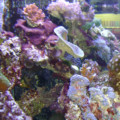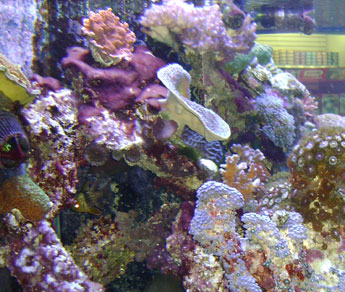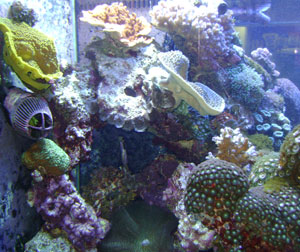Refugiums Control High Nitrate and Phosphate Levels – Even Unwanted Algae!
High levels of nitrates and phosphates have frustrated many a saltwater hobbyist. Now refugiums are here to save the day! A refugium uses macro algae, mud and/or sand as natural filters for reducing nitrates, silicates, and phosphates. As you harvest (remove) macroalgae you are also removing excess nutrients from the aquarium. Reducing excess organic nutrients helps control unwanted algae growth in the display aquarium.
Since a refugium is generally separate from the main aquarium it provides protection for copepods and amphipods, giving your aquarium a constant, natural food source. This natural food can be netted from the refugium or will travel naturally to the display aquarium via the lines connecting the two. Predators such as fish, shrimp, and corals should never be placed in your refugium.
There Are Four Refugium Styles
Comments Off on Refugiums Control High Nitrate and Phosphate Levels – Even Unwanted Algae!
Live Red Hair Algae Removal

 Many kinds of unwanted algae can overtake a saltwater aquarium when left unchecked. Mainly I see a lot of green hair algae, bryopsis, but recently I had the opportunity to work with a reef covered in red hair algae. The first photo shows just one area of the aquarium with red hair algae. But I can assure you it was spread throughout the entire aquarium.
Many kinds of unwanted algae can overtake a saltwater aquarium when left unchecked. Mainly I see a lot of green hair algae, bryopsis, but recently I had the opportunity to work with a reef covered in red hair algae. The first photo shows just one area of the aquarium with red hair algae. But I can assure you it was spread throughout the entire aquarium.
This reef has a refugium, some blue and red leg hermit crabs, astraea and nassarius snails. The refugium and invertebrates are great at helping keeping in check most algae but they did nothing to rid the aquarium of the unsightly red hair algae! I prefer to use natural solutions rather than adding chemicals, so, in this case I called on the Pacific Coast Mexican Turbo snails (Turbo fluctuosus) to the rescue.
Three and a half weeks after adding 12 Mexican Turbo snails to this 120 reef there were no more visible traces of the red hair algae. There is one concern when adding these Turbo snails – Read More Here…
Comments Off on Live Red Hair Algae Removal
What Should The Specific Gravity Be In My Aquarium?
 Although there are currently a few saltwater fish hatcheries, most saltwater fish sold in fish stores are collected from the oceans. The salt content or specific gravity of ocean water varies in different parts of the world as well as individual oceans. These saltwater fish which are collected from various oceans are shipped to aquarium stores and homes and are expected to live in whatever specific gravity the aquarium keeper decides on.
Although there are currently a few saltwater fish hatcheries, most saltwater fish sold in fish stores are collected from the oceans. The salt content or specific gravity of ocean water varies in different parts of the world as well as individual oceans. These saltwater fish which are collected from various oceans are shipped to aquarium stores and homes and are expected to live in whatever specific gravity the aquarium keeper decides on.
Back in the 1980’s and early 90’s I recommended my customers to keep specific gravity for their saltwater fish aquariums at 1.020. The theory back then was that parasites were less prevalent at lower levels of salt. This theory has been proven completely wrong – parasites continue to thrive at this level. Specific gravity has to be much, much lower to kill parasites. The flip side is that most fish also thrived at a specific gravity of 1.020. But then I recommended my customers to keep specific gravity higher in aquariums with invertebrates and live corals.
Eventually it seemed to make sense to maintain a common specific gravity for all the saltwater Read More Here…
Comments Off on What Should The Specific Gravity Be In My Aquarium?
The Green Wolf Eel Can Be A Great Saltwater Fish To Add To Your Aquarium
Green Wolf Eels or Carpet Eel Blennies are fish that look like, are named like, and are commonly mistaken for eels. Green wolf eels (Congrogadus subducens) are really a pseudochromid (Dottyback.) These hardy fish are frequently for sale at most fish stores.
One of the neat features about this fish is its great eyesight. When a customer asks about this fish I generally grab a tuffy (rosie red minnow) or a small feeder goldfish and hand feed it. Even though Green Wolf Eels are wild-caught in a very short time they will eat out of your hand. I have never had one miss the food and bite me but it is probably wise to use feeding tongs, it’s just not as cool.
Green Wolf Eels grow to a maximum length of almost 18″ so it requires an aquarium of at least 55 gallons. They need a meaty diet consisting of foods like krill, shrimp, squid and other frozen and live fish. They generally are quick to learn to eat in captivity but if you have a finicky eater feed it glass Read More Here…
Comments Off on The Green Wolf Eel Can Be A Great Saltwater Fish To Add To Your Aquarium